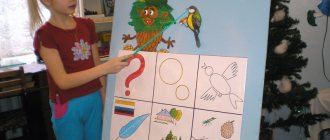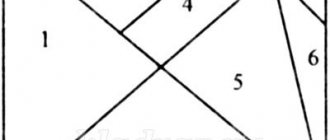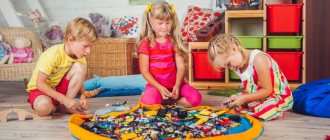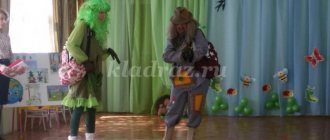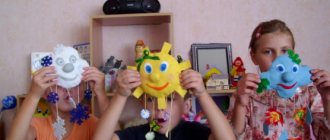Games for speech development in the senior group of kindergarten
Didactic games for the speech development of children in the senior group
“Find the extra word” Purpose:
to exercise the development of mental processes of generalization, abstraction, and identification of essential features.
Progress of the game.
Invite your child to identify the word that is redundant.
Read a series of words to your child. Each series consists of 4 words. 3 words in each series are homogeneous and can be combined based on a common feature, and 1 word differs from them and should be excluded. List of series of words: 1. Old, decrepit, small, dilapidated. 2. Brave, angry, daring, daring. 3. Apple, plum, cucumber, pear. 4. Milk, cottage cheese, sour cream, bread. 5. Hour, minute, summer, second. 6. Spoon, plate, pan, bag. 7. Dress, sweater, hat, shirt. 8. Soap, broom, toothpaste, shampoo. 9. Birch, oak, pine, strawberry. 10. Book, TV, radio, tape recorder “Is this true?” Goal:
development of auditory attention, activation of the verb vocabulary.
Progress of the game.
Children are read a poem containing absurd situations.
Children must answer the question: “Is this true? – after each sentence and prove why they think so. For the correct answer they get a chip. The one who gets the most chips wins. Is this true? They collect cheese from the bushes. Cows are grazed with hares. Oxen are being milked in the meadow. The bear starts dancing. The pumpkins began to sing songs. Mowers are mowing the forests. There is dew on the snow. Is it true that once an umbrella saved us from the rain? Why does the moon shine on us at night? What don't children like sweets? L. Stanch “The Fourth Extra” Purpose:
to teach to establish the similarities and differences of objects according to essential features, to consolidate generalization words.
Progress of the game.
Four pictures are laid out on the table, three of them belong to one thematic group, and the fourth to some other group.
The children are given a task: look at the pictures and determine which one is the odd one out. Turn over the wrong picture, and name the remaining ones in one word.” Each participant eliminates the extra picture in turn. If he makes a mistake or does not complete the task, his version is offered to the next player to complete. For each correct execution they give a chip. The one who collects the most chips wins. A series of pictures for the game: 1. Shirt, shoes, trousers, jacket. 2. Apple, gooseberry, currant, raspberry. 3. TV, wardrobe, chair, bed. 4. Cuckoo, owl, butterfly, magpie. 5. Plate, bread, pan, spoon. 6. Chamomile, birch, spruce, poplar. 7. Tomato, cucumber, carrot, plum. 8. Cap, beret, hat, sock. 9. Axe, saw, handle, plane. 10. Bear, fox, teddy bear, hare. “Right or wrong?” Goal: learn to find grammatical errors. Progress of the game.
“Do you think it’s possible to say that?”
1. Mom puts a vase of flowers on the table. 2. When they want to buy something, they lose money. 3. Grandmother and grandfather live under the house on the edge of the forest. 4. There is a beautiful carpet on the floor. “Why are the sentences inaccurate? – the teacher additionally asks the children. “Unravel the words” Goal: learn to compose sentences using these words. Progress of the game. The words in the sentence are mixed up. Try to put them in their place. What will happen? Suggestions for the game: 1. Smoke, coming, pipes, from. 2. Loves, little bear, honey. 3. Standing, in a vase, flowers, in. 4. Nuts, in, squirrel, hollow, hiding. “Find the error” Purpose: to teach how to find a semantic error in a sentence. Progress of the game. “Listen to the sentences and tell me if everything in them is correct. How should the sentence be corrected? 1. In winter, apples bloomed in the garden. 2. Below them lay an icy desert. 3. In response, I nod my hand to him. 4. The plane is here to help people. 5. I soon succeeded by car. 6. The boy broke the ball with glass. 7. After the mushrooms there will be rains. 8. In spring, the meadows flooded the river. 9. The snow was covered with a lush forest “Explain why...” Purpose: to teach correctly, construct sentences with a cause-and-effect relationship, develop logical thinking. Progress of the game. The facilitator explains that the children will have to complete the sentences that the facilitator begins to say using the word “because.” You can select several options for one beginning of a sentence, the main thing is that they all correctly reflect the reason for the event stated in the first part. For each correctly executed continuation, players receive a chip. The one who collects the most chips wins. Unfinished sentences for the game: Vova got sick... (got a cold) Mom took an umbrella... (it's raining) The children went to bed... (late) I'm really thirsty... (hot) The ice on the river melted... (warm) The trees swayed a lot... (the wind is blowing) It became very cold... (it started snowing) “Say a word” Goal: to reinforce the use of nouns in the genitive plural in speech. Progress of the game. Familiar lines of poetry are read aloud to children, without finishing the last word. (This word is in the genitive plural). Children add the missing word and receive a chip for each correct answer. The one who gets the most chips wins. *** I give you my word of honor: Yesterday at half past six. I saw two pigs. Without hats and... (shoes) *** Wait, wasn't it for you Last week. I sent two pairs of Excellent... (galoshes) *** Robin Bobin Barabek. Ate forty... (man) *** He said: “You are a villain, You devour people, So, for this my sword - Your head from... (shoulders) *** Ant, ant Does not regret... (bast shoes) *** Where is the killer , where is the villain? I’m not afraid of him... (claws) -5- “It flies, not a bird” Purpose: differentiation of the concepts of “birds” and “insects”. Progress of the game. The presenter asks riddles about birds and insects. Children solve the riddles and explain which thematic group this animal belongs to. If the answer is correct, the presenter gives the child a chip or a symbol of that animal. The one who collects the most chips wins. Before the game, the presenter reminds the children of the identifying characteristics of birds: they have feathers, beaks, claws, wings, they build nests and hatch chicks, they can sing, they are big. Insects are small, have six legs, do not hatch chicks, and have no feathers. In the dark dungeon, the maidens are beautiful. Without thread, without knitting needles Knitting. (Bees in the hive) *** Red paws Pinching the heels (Goose) *** Black, agile, Shouts “krak”, Enemy of worms. (Rook) *** Not an animal, not a bird, But a nose like a knitting needle. (Mosquito) *** Appeared in a yellow fur coat. Goodbye, two shells. (Chicken) *** A bird flew, Not feathered, not winged, Long nose, Thin voice. Whoever kills her will shed human blood. (Mosquito) Many craftsmen cut down a hut without corners. (Ants) *** A little boy in a gray shirt scurries around the yards, collects crumbs, spends the night in the field, steals hemp. (Sparrow) *** In a clearing near the fir trees, The house is built of needles. It is not visible behind the grass, but there are a million residents in it. (Anthill.) *** There is a palace on a pole, There is a singer in the palace, And his name is... (starling). *** I buzz, I buzz, I sit on a branch, I keep repeating the letter Z, Knowing this letter firmly, I buzz in the spring and summer. (Beetle) *** Vereshchanya, white-sided. And her name is... (magpie). *** The flower was sleeping and suddenly woke up: He didn’t want to sleep anymore. He moved, perked up, soared up and flew away. (Butterfly)
We recommend watching:
Games for the development of speech for children 5-7 years old Speech games and exercises for the development of speech for children 5-7 years old Didactic games for children 5-7 years old: Winter sports Didactic game for children 4-7 years old. Shop "Tails"
Similar articles:
Assignments on the topic “Forest” for children 6-8 years old
Methods of using didactic games in kindergarten in the senior preparatory group
Games for the formation and development of vocabulary
"Pack your luggage"
Generalization and grouping by characteristics
To begin, prepare cards with images of various objects in such a way that at least every 3 (or more) of them relate to the same topic or can be generalized according to some characteristic (food, toys, everything green, everything soft, found only in winter) . There should be as many thematic features as there are participants playing, plus 1-2 “spare” ones. Give each player a basket (box, suitcase). Hide the cards in an opaque container or turn them upside down.
Tell the children that soon you will go to a distant magical land. Everyone can take with them in their luggage only those things that have some common feature. Invite the first child to draw one card at random. Discuss with the children the properties of this object, its purpose, remarkable features, differences. The first card will go into the first player's "suitcase".
The second child pulls out his card. The discussion is repeated. Work with your children to determine whether this item is in the same category as the first. If yes, the first player takes the card. If not, the second person puts this item in his “baggage” and passes the turn to the next participant.
The game continues until each child has 3 items in their suitcase (or more if you have selected more than 3 thematic cards of each type for each player).
"Shifters"
Selection of antonyms
The game is dynamic, suitable for working with the ball (throwing it to each other, calling the word), relay races, jumping, etc.
The presenter calls the word and hands the child the ball (or performs another action). In response, the child must name the word that has the opposite meaning as quickly as possible. Players can give each other hints, developing an active vocabulary together.
"Journalists"
Formulating questions, using verbs
Tell us that today the children will work as journalists and interview each other. Prepare two chairs, as in a real TV broadcast, an improvised microphone and call the first pair of participants.
For each, prepare a certain topic, event or phenomenon about which you can tell what exactly it does. Whisper the topic (in one word) into the ear of the “journalist” and offer to “take an interview” - make up the question “What does it do?” with the hidden word. The second child will have to answer the question, remembering the skills, abilities and capabilities of the hidden noun.
Example: Sun. “Tell me, what does the sun do? – The sun is shining, warming, rising, shining.
Dog. “Please tell us what the dog is doing? – Barks, bites, growls, guards.
After the interview is over, the floor is given to the “guests in the studio,” other children, asking them to come up with other verbs related to this noun. Then the participants change roles, repeat the game with other words, and then give way to the next pair. The guest who names the most verbs (both as a player and “from the audience”) is awarded a prize.
Breathing exercises for the development of speech breathing in children
"Interpreters for Chinese tourists"
Selection of synonyms
Tell your children that it is sometimes very difficult for a person who does not know the language well to understand the meaning of certain words. And words that are similar in meaning can come to the rescue.
Introduce the children to a doll (bear, etc.) that came to visit from another country - China. She doesn't know Russian well because she just started learning it. She needs help to understand some Russian words.
Show children cards with the definitions of different words (or say them out loud) and offer to explain their meaning to a foreigner using just one word. Involve all the children in the game - let them come up with synonyms collectively.
Games for developing coherent speech
Incompetent writer
Speech development of children 4-5 years old in the middle group of kindergarten by topic
Formulation, construction of complex sentences, development of logical thinking
A writer came to visit the children who could not finish a children's book, because his stories had a beginning, but nowhere was there an ending. He asks the children for help: tell me how each of the stories could end.
Read the beginning of prepared sentences, then add a “why” question and ask children to begin their answer with “because,” and then repeat the entire sentence.
Examples:
“Dad brought home a cake and put it on the balcony.. (why?) because our refrigerator was broken.”
“Masha won’t go to bed at nine o’clock today... (why?) Because today is December 31st, and everyone is celebrating the New Year.”
“A striped cat climbed a tall tree and meows... (why?) Because it can’t come back down.”
Head or tail?
Making a story based on a picture
For the game, prepare plot serial pictures illustrating a single story. Mix them up and tell the children that the magic snake, who can read and tell stories, is asking for help: you need to arrange the pictures in the order in which the fairy tale depicted on them develops. Discuss each card, ask the children, encourage them to talk about what is drawn, in which part of the chain it should be placed.
Upon completion of the task, ask the snake to “read” the resulting story.
In pursuit of fashionable and modern games, do not forget about the classics of children's yard games that are familiar to you from childhood. “Edible/Inedible” and “Broken Phone” have been among the most popular and generation-tested games for speech development for decades.
